Government and Public Policy
Measuring WellbeingWellbeing economics and analysis
In our report, we use the Civil Service People Survey to analyse the wellbeing of civil servants across central government departments, as well as regulators, arms length bodies, and the Scottish and Welsh governments.
This builds on our previous paper, published in July 2022, which indicated that wellbeing was improving after the impact of the pandemic. With the addition of another year of data, we explore whether the service’s recovery has continued and how these insights can be used in practice.
Key findings
The Civil Service People Survey is taken by staff each year and measures four indicators of subjective wellbeing; Life Satisfaction, Worthwhileness, Happiness and Anxiety, alongside other people engagement survey questions. Results are available from 2011/12 until 2021/22.
New data suggests that:
- The recovery previously observed post-pandemic has stalled in 2021-22, with many wellbeing measures showing no improvement.
- Although results are not uniform, there is less variation within the measures than we have seen before, showing a more generalised experience.
- Across the wider service, no organisations have fully recovered to pre-pandemic levels, with each one experiencing a rise in Anxiety since 2019.
- Only HMRC has partially recovered reporting Life Satisfaction, Worthwhileness and Happiness measures at pre-pandemic levels. As with other departments, Anxiety remains high.
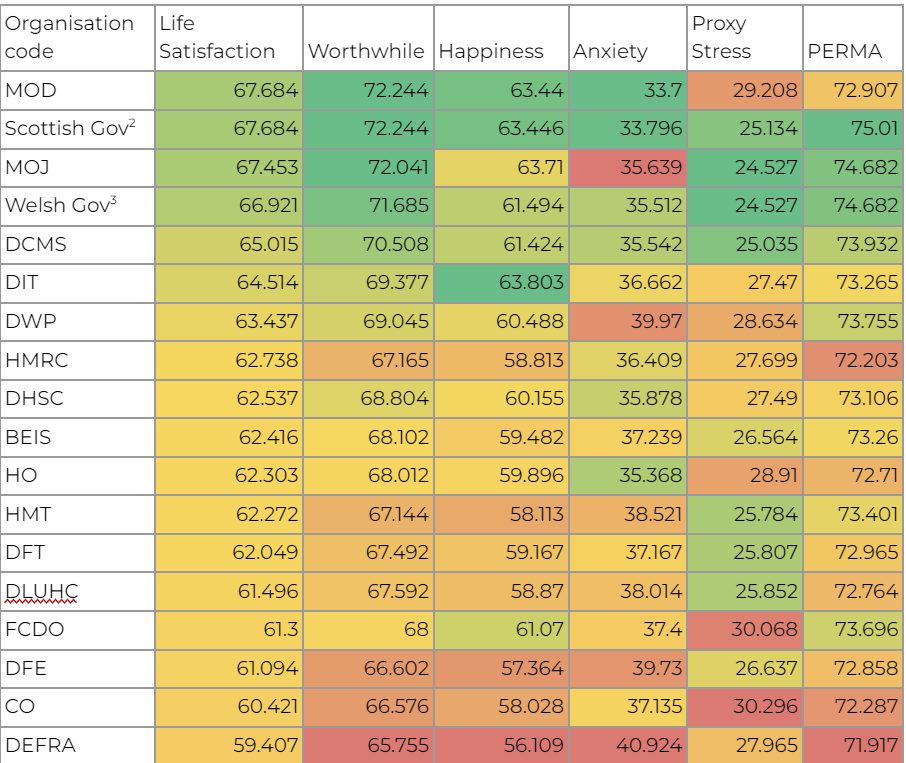
Percentage of Civil Service staff with high wellbeing 2022
Recovery plateaued
The Survey data provides valuable insight into general wellbeing in different government organisations before, during and through recovery from the pandemic. It gathers wellbeing data from people working in the civil service at that point, rather than the same people over time.
Pre-pandemic trends for all four indicators of personal subjective wellbeing were encouraging, and Civil Service data showed improvement before 2020.
Unsurprisingly, the pandemic overturned these trends, with Life Satisfaction, Worthwhileness and Happiness decreasing and Anxiety rising in 2020 in line with the general population. There was greater variation in the Anxiety measure meaning some groups of staff reported higher levels than others.
Although the pandemic had a substantial negative impact on wellbeing, around half of this drop had been recovered by 2021, suggesting that the civil service’s wellbeing was on a positive trajectory. The trend indicated that the service could be fully ‘recovered’ from the wellbeing effects of Covid by 2022.
In 2022, we see that this is not the case:
- Life Satisfaction, Worthwhileness and Happiness levels have remained almost perfectly static between 2021 and 2022. While they remain statistically significantly better than in 2020, but show no improvement since 2021.
- Anxiety, which showed slower recovery going into 2021, has risen since 2021.
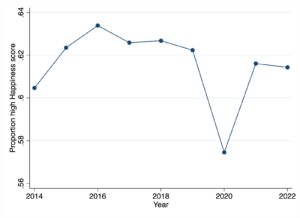
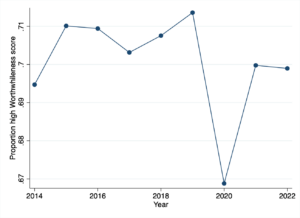
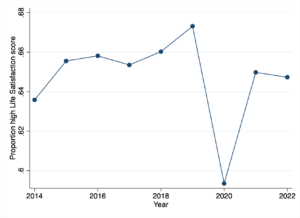
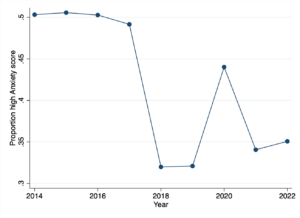
It seems that wellbeing of civil servants has stalled, with Anxiety increasing.
Whilst Anxiety levels of the general population have reduced, they remain higher than pre-pandemic as a whole and are particularly high for those of working age.
Is this consistent across the civil service?
Experiences are not uniform across the public service, with variation across departments. The distribution of changes is narrower this year than last year, suggesting a more similar experience
The latest data (2021-22) from central government departments are particularly striking, with more than a third experiencing drops in wellbeing across all four measures. Of all the central government departments for which data are available, only HMRC has partially recovered wellbeing to pre-pandemic levels, although it still retains higher Anxiety than pre-pandemic.
The importance of workplace data
We know that being employed is an important driver of life satisfaction. Beyond having a job or not, the quality of our job and how satisfied we are with it is important for our overall wellbeing. A workforce’s wellbeing is a significant concern within the workplace and wider society.
Collecting and analysing workplace wellbeing data provides an understanding of how staff wellbeing is affected over time across organisations, type of work and in the context of the wider world. Measurement of job quality is still unclear, but Job Satisfaction has been improving in the UK over the long term since 2015/16.
How can we use these insights?
The scale of the survey and its continuation over time enables a better understanding of how wellbeing and work interact.
The same people are not being surveyed each time and therefore data can only tell us about the state of wellbeing in the organisation in general; but we can look at the interaction between other measures of staff surveys and national population trends.
There is also a range of types of work, sectors and regions of the UK in the Civil Service data which is useful for building a picture of wellbeing and work more widely. Our aim in doing this analysis is to better understand what organisations can do to improve wellbeing in all 19 sectors of the economy.
In order to better understand what workplace interventions support and improve staff wellbeing, we need better quality efficacy studies. At the moment, there is an opportunity to do trials and quasi-experimental studies with staff groups of 2000+, over one to five years.
If there is an intervention ready to test in your sector, do get in touch.
UKRI – Creating Opportunities Trial Accelerator Fund 1-5 year
UKRI – Creating Opportunities Evaluation Development Fund up to 12 months
